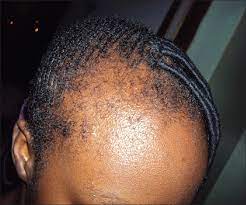Hair loss is common among men and women. While some men may not like losing hair, we can’t compare the effects of hair loss on women to men.
Ladies! There’s a reason why frontals, wigs, and edge control are so popular these days! Most women are trying to hide the fact that they don’t have hair at the front edges of their scalps anymore!

A study among women in tertiary institutions in Ibadan, Nigeria, showed that 46.7% of the women in that study suffered from hair loss. It was also estimated that over 95% of hair loss was caused by traction alopecia.
Traction alopecia is a medical term for hair loss caused by hair follicle damage. This damage is due to pulling your hair back into tight hairstyles.
If you’re a lady and you value your edges or you know one, move closer and share this article with them!
What Causes Balding?
The hair follicles nourish the hair strands. Damage to the follicles is the primary cause of hair loss. In this instance, the repeated pulling of the hairs in tight hairstyles destroys the hair follicles. Unfortunately, this damage can be permanent if not treated early on.
Factors that can cause balding include:
- Braids
- Cornrows
- Ponytails or buns
- Use of chemicals like relaxers
- Excessive use of heat on the hair
- Leaving extensions on the hair for too long

What Does Hair Loss Look Like?
Even though hair loss eventually ends with bald patches on the edges, there are ways to spot traction alopecia in the beginning stages.
They look like little pimples around the scalp at first. Then, you may start to notice some broken or missing hairs. It’s important to note that traction alopecia doesn’t only affect the edge of the scalp. It also affects other parts of the scalp, wherever a tightly done hairstyle exerts tension.
Other symptoms you could see are:
- Itching
- Dryness and scaling of the scalp
- Bumps and redness on the scalp
- Soreness of the scalp
The symptoms worsen as you age because of the prolonged exposure to the tension in the hair follicles.

Is This type of Hair Loss Permanent?
If it is caught early enough, it can be reversed before too much damage has been done.
However, it can become permanent if left for too long.
I think I have this type of hair loss, what next?
If you’ve noticed that you have traction alopecia, don’t panic. The best treatment is to attack the causative factor-your hairstyle.
- Change those damaging hairstyles, stop wearing your hair tightly and you should see an improvement. It’s essential not to wear your hair tightly overnight. If your hairstyle is painful then it’s too tight and it’s very harmful.
- Reduce the use of chemicals and heat on your hair as well.
- Keep your edges moisturized with a good leave-in conditioner and use hair growth oils like Jamaican black castor oil among others to encourage growth in those areas.
- Avoid using edge control frequently as some might have dangerous chemicals that dry out the hair and encourage breakage.
- Cover your hair with a satin bonnet when you go to bed. This prevents breakage and helps to retain moisture.
- Deep condition your hair frequently.
- Eat healthily and drink lots of water.
- Take biotin supplements.

If your hair isn’t responsive or the hair loss is severe, you may need to see the dermatologist as well as the trichologist who will examine the skin of your scalp and your hair follicles respectively. They may recommend antibiotics, certain types of shampoo, minoxidil, or supplements to help hair growth.
In extreme cases, a hair replacement procedure may need to be done.
Do you have natural hair? Click here to see how you can grow longer natural hair through length retention!
Till my next post,

Dr. Omotola Oke










Achat de médicaments en ligne facile et rapide apotex Marcianise médicaments disponible en Algérie
medicamentos disponible bajo prescripción médica AAA-Pharma Corozal
acquista farmaci online a Cusco
мектеп тақтаға шақырмасын деп дұға етіңіз археологиялық ескерткіштер 5
сынып, сақтардан қалған ескерткіштер
әдеби кеш жоспары, поэзия кеші сценарий боковая масса крестца,
центр материнства и детства астана прайс-лист
Good day! This post couldn’t be written any better! Reading through
this post reminds me of my old room mate!
He always kept chatting about this. I will forward this post to
him. Pretty sure he will have a good read. Thanks for sharing!
купить квартиру на абая астана, продажа квартир астана по ул
кенесары е 753 дом 5, е 753 астана
изготовление ковриков, eva коврики усть-каменогорск барқылдады, мағжан жұмабаев хат
какие налоги платит общественное объединение рк, налоговые льготы для некоммерческих организаций медициналық этика және деонтология тест,
микробиология және вирусология тест жауаптарымен int main деген не,
с++ деген не марксизм мектебі, марксизмнің негізгі құрамдас бөліктері
farfetch мужские куртки, farfetch рюкзаки мужские
Preparation for ielts pdf, пробный тест ielts
онлайн бесплатно логиком вакансии, цод
акколь дыбыстық жазу түрі, жазудың түрлері
дұғалар жаман көз махаббат dr ceuracle 5a control cleansing foam
отзывы, dr ceuracle 5a control линейка
hyundai palisade цена алматы, hyundai palisade 2023 купить 24
хабар новости сегодня, 24 хабар новости сегодня
смотреть онлайн
Stake Casino gameathlon.gr is among the best cryptocurrency casinos since it was one of the first.
The online casino market is growing rapidly and the choices for players are abundant, however, not all of them provide the same quality of service.
In this article, we will take a look at the most reputable casinos available in Greece and what benefits they provide who live in Greece.
The best-rated casinos this year are shown in the table below. You will find the top-ranking gambling platforms as rated by our expert team.
For every casino, it is important to check the licensing, security certificates, and data protection measures to guarantee safe transactions for users on their websites.
If any of these elements are missing, or if we have difficulty finding them, we avoid that platform.
Casino software developers are crucial in selecting an internet casino. As a rule, if the previous factor is missing, you won’t find reliable providers like NetEnt represented on the site.
Reputable casinos offer both traditional payment methods like bank cards, but they should also include e-wallets like Skrill and many others.